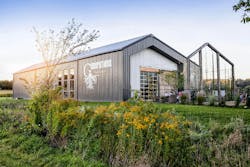Why architects and engineers like metal building systems
From the stand-point of architects and engineers, there’s a lot to like about metal building systems. The combination of design flexibility and high value-to-cost enable design professionals to provide their clients with cost-effective solutions for their practical and aesthetic requirements.
Over the past 20 years, architects across the US have been proving that a metal building can be many things. A car dealership with an enormous glass front, a traditional-style church with stone buttresses, or a contemporary-styled university arts center are not the kind of projects that people usually think of as metal buildings, yet they have all been constructed by Star builders within the past few years. What these three facilities – and many others – have in common is that they all benefit from the one property that metal building systems provide best: large open interiors.
Almost everything else about them is different, but all those variations are within the capabilities of metal buildings, because the system is highly versatile, and getting more so all the time.
Architects and engineers are finding that the structural steel frame is easy to add onto and build out, enabling them to achieve shape and massing significantly different than the profile of central steel structure. The aforementioned church, for example, was built out with additional light gauge steel framing to create two steeples, a portico, and more. Designers get to leverage the cost and construction speed advantages of a metal building system without being limited to the structural system’s shape.
Some architects may be (pleasantly) surprised to learn that metal building systems are compatible with large-scale glazing, including full-height glass walls. It is an ideal structural system for retail projects or automobile showrooms, as well as restaurants.
Although metal buildings were, in the past, closely associated with metal panels as the building envelope, designers are increasingly applying other architectural finishes. Stone veneers, brick veneers, EIFS, and more are possible. Ironically, as these options were first being explored to expand the range of metal building systems, metal panels began to be embraced by the design community as an architectural finish for many types of structures. While metal building systems are no longer tied to metal panels, the “metal building look” has begun to take over other forms of construction.
Another plus for engineers is that a Star metal building system is fully engineered by Star. The Star computer design software is fully loaded with the codes of all 50 states and Canada, speeding up the engineering process for the building as a whole. Even in a hybrid structure where only the top floor is a metal building system, that portion of the engineering is handled, shortening design time and allowing the project to move forward more quickly.
One of the biggest reasons design professionals select metal building systems is the opportunity to provide their clients with more building for less money. This is especially true in certain types of projects where the owners are trying to satisfy very large space needs on a very limited budgets, such as churches, schools, manufacturing facilities and warehouses. The economy of a metal building system often makes projects possible that would be prohibitively expensive using other construction methods. This can be the difference between building or not building.
The architect of a church in Oklahoma put it very succinctly. “The value from the metal building system is what allowed the church to happen. If they had tried to deal with glue-lams and custom wood, they wouldn’t have made it there.”

